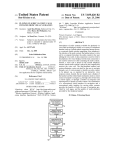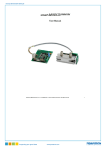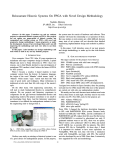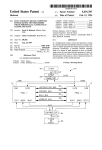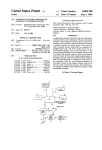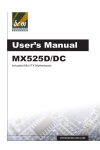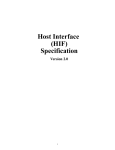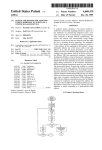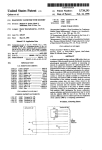Download Interrupt handling that disables interrupts upon saving the registers
Transcript
USO05717933A
United States Patent [191
Mann
[54] INTERRUPT HANDLING THAT DISABLES
INTERRUPTS UPON SAVING THE
REGISTERS
'
5,717,933
Patent Number:
[45] Date of Patent:
[11]
Feb. 10, 1998
Book entitles “Am29050TM Microprocessor” User’s
Manual, published @1991 Advanced Micro Devices. Inc.
.
Brochure entitled “Am290001'M and AM29005TM Stream
[75] 1mm“ Dame‘ P- M?m- Ausm T“
lined Instruction Microprocessors”. published @1992
[73] Assignee: Advanced Micro Devices, Inc.,
Advanccd Micro Devi°e5~ Inc
Sunnyvale. Calif.
[222
[
Pa d. Nb‘z A
1
e '
29 1996
ug'
AssistantExaminer-Jack
Examiner-David
B. A. Wiley
’
Attorney Agent, or Firm-Skjerven. Morn'll. MacPherson.
Related US. Application Data
Franklin & Friel LLP; Ken I. Koestner
[63] Continuation of Ser. No. 52,347, Apr. 23, 1993, abandoned.
In
.6
06F
U; Cell
[58]
[57]
ABSTRACT
46
G 3952,35
To speed up interrupt processing by interrupt handlers
395/735
Field of Search
395/725
“muting with im'm‘ll’ts disablcd- ‘m °‘ 111°“ Prom-“5°r
registers in the computer system are reserved for exclusive
use by software executing with interrupt disabled. Interrupt
processing code can be written in a high level language. If
‘ha “d6 generated by “m high “v61 languag? comP?Cr “$65
.. 395/650
non-reserved registers. these registers are saved by the
9/1994 Kmzko
395,725
rupt processing code is invoked. After execution of the
5,560,032
9/1996 Nguyen et a].
395/800
interrupt processing code. the interrupt handler restores the
5,600,823
2/1997 Sherer et a].
395/500
non-resm'ved registers from the reserved registers. Saving
the non-reserved registers in the reserved registers rather
than in a memory improves the interrupt processing speed.
[561
References Cited
U5, PATENT DOCUNIEN'I‘S
5,050,067 9/1991 McLagan et al.
5,161,226 11/1992 Wainer
5:11: 231'
5349’667
inteirupt handler in the reserved registers before the inter
OTHER PUBLICATIONS
Book entitled “RISC Design-Made Easy—Appl.ication
Guide”. 29K. published @1992 Advanced Micro Devices.
34 Claims, 3 Drawing Sheets
Inc.
110
\
MEMORY
W
120
1 24
PROCESSOR
~114
GENERAL
PRQGRAMS”130
144
\
INTERRUPT HANDLER /140
/
144-1 we WITH INTS DISABLED
L
PURPOSE REGISTERS
REGISTERS
REGISTERS
"- RESERVED FOR CODE
OTHER REGISTERS
SAVE GENERAL
IN RESERVED
PURPOSE
,
,
_
’‘ 140 1
ENVOKE INTERRUP'T
140 2
PROCESSING CODE
"’
-
RESTORE SAVED
REGISTERS
FROM RESERVED
REGISTERS
“440-3
RETURN FROM
INTERRUPT
4,140!‘
144-2
SPECIAL
PURPOSE
REGISTERS
I l
F1
/
_148
148 1
“148-2
"r’
-
US. Patent
Feb. 10, 1998
"’ 120
MEMoRY
Sheet 1 of 3
‘2E4
5,717,933
PRDGESSDR
'v1 1 4
GENERAL
@130
PROGRAMS
144
PURPOSE
REGISTERS
\
INTERRuPT HANDLER K140
SAVE GENERAL
144" ‘
/
IN RESERVED
I
REGISTERS
ENVOKE INTEHRUPT
"/1402
REsToRE SAVED
REGISTERS
FRoM RESERVED
“V1403
REGISTERS
INTERHUPT
144.2
I
PRocEsSING coDE
RETURN FROM
W" ‘m5 D‘SABLED
L
4,140.1
HG_ 1
4,140.4
PURPOSE
REGISTERS
OTHER REGISTERS
PURPOSE REGISTERS
SPECIAL
_
,/ 14B
q/14a2
U.S. Patent
Feb. 10, 1998
Sheet 2 of 3
5,717,933
INTERHUPT CACHE
Fast way of dealing with Freeze-mode interrupt handlers
; Daniei Mann
.macrointerrupt_cache, trap_number, C__handler, nregs
sub
gr1,gr1,4*4
;get ir0-ir3 space
asgeu V_SPiLL,gr1,rab ;checkfor stack spill
add ir1,gr121,0
;save gr121
add ir0,gr96,0
;save gr96
const gr121,290
;HIF 2.0 SETTRAP service
const lr2,trap_number ;trap number, macro parameter
const |r3,$1-(nregs*4) ;trap handier address
consth
asneq
add
add
add
lr3,$1-(nregs*4)
69,gr1,gr1
gr121,|r1,0
gr96,|r0,0
gr1,gr1,4*4
;HIF service request
;restore gr121
;restore gr96
;restore stack
jmp $2
asleu V_FlLL,lr1,rib
;macro code finished
;check for stack fill
add
add
add
add
add
gr80,gr111,0
gr79,gr110,0
gr78,gr109,0
gr77,gr108,0
gr76,gr107,0
;save gr111
add
add
add
add
add
add
add
add
gr74,gr105,0
gr73,gr104,0
gr72,gr103,0
gr71,gr102,0
gr70,gr101,0
gr69,gr100,0
gr68,gr99,0
gr67,gr98,0
add
gr75,gr106,0
FIG. 2A
add
gr66,gr97,0
;save gr97
add
gr64,ir0,0
;save lr0
const
consth
calli
add
|r0,C_handier
ir0,C_handler
ir0,lr0
gr65,gr96,0
$1:
140,02
;save gr96
140 1
'
US. Patent
jmp
$2:
Feb. 10, 1998
Sheet 3 of 3
$2-4-(n regs*4)
add
lr0,gr64,0
;restore lrO
add
add
gr111,gr80,0
gr110,gr79,0
;restore gr111
add
add
add
add
gr109,gr78,0
gr108,gr77,0
gr107,gr76,0
gr106,gr75,0
add
gr105,gr74,0
add
gr104,gr73,0
add
add
add
add
add
add
add
add
gr103,gr72,0
gr102,gr71,0
gr101,gr70,0
gr100,gr69,0
gr99,gr68,0
gr98,gr67,0
gr97,gr66,0
gr96,gr65,0
1 40 3
'
;restore gr96
iret }14o.4
.endm
FIG. 28
KEY TO
FIG. 2
FIG. 2A
FIG. 2B
5,717,933
5,717,933
1
2
IN'I‘ERRUPT HANDLING THAT DISABLES
INTERRUPTS UPON SAVING THE
REGISTERS
registers for code executed with interrupts disabled. Thus, an
inten'upt handler executing with interrupts disabled may use
the reserved general purpose registers without saving them.
If an interrupt handler uses any non-reserved genm'al
purpose registers, the interrupt handler saves the non
reserved registers in the reserved registers rather than in the
memory. Since register access is typically faster than
This patent is a continuation of US. Pat. Ser. No.
08/052,346 ?led Apr., 23, 1993. now abandoned.
A portion of the disclosure of this patent document
contains material which is subject to copyright protection.
memory access, the interrupt latency is improved. The
register restoration time is also improved because restoring
the non-reserved registers from the reserved registers is
faster than restoring from the memory.
The copyright owner has no objection to the facsimile
reproduction by anyone of the patent document or the patent
disclosure. as it appears in the Patent and Trademark O?ice
patent ?le or records, but otherwise reserves all copyright
The invention is suitable in some embodiments for writ
rights whatsoever.
ing interrupt processing code in a high level language. If the
high level language compiler generates code which uses
non-reserved registers, the interrupt handler, before invok
ing the interrupt processing code. saves the non-reserved
registers in the reserved registers.
BACKGROUND OF THE INVENTION 1. Field
of the Invention
The present invention relates to computer systems. and
more particularly to interrupt handling in computer systems.
2. Description of Related Art
A typical computer system includes a processor which
Other features and advantages of the invention are
described below. The invention is de?ned by the appended
claims.
executes software stored in a computer memory. When an
interrupt occurs, the processor executes software called an
interrupt handler. On occurrence of an interrupt, the com
puter system hardware and/or the interrupt handler typicaily
25
save the processor registers which can be destroyed by the
interrupt handler because these registers may be needed for
the interrupted program. General purpose registers, i.e.,
registers which can be modi?ed directly by arithmetic and/or
logical operations, are saved in the memory.
Before returning to the interrupted program, the interrupt
handler and/or the system hardware restore the saved reg
DESCRIPTION OF THE PREFERRED
FIG. 1 illustrates a computer system 110 providing a short
interrupt latency and a short register restoration time. Pro
The register saving increases the interrupt latency de?ned
35
interrupt processing code. The interrupt processing code is
that part of the interrupt handler which is not related to
register saving and restoration. To increase the system speed,
it is desirable to improve the interrupt latency and also to
improve (Le, reduce) the register restoration time at the end
cessor 114 and memory 120 are connected by interface 124.
In some embodiments, interface 124 is a collection of
conductors connecting the respedive address, data and con
trol ports of the processor and the memory. In other
embodiments, interface 124 includes a memory controller,
address latches, data bu?‘ers, and/or other circuitry as is
known in the art.
Processor 114 and memory 120 are formed of discrete
components or are embedded into an integrated circuit. In
some embodiments, processor 114 is a RISC microprocessor
of interrupt handling. Improving the interrupt latency and
the register restoration time is particularly important for
interrupt handlers executed with interrupts disabled because
other interrupts may be missed while such an interrupt
handler is executing.
Thus, it is desirable to provide interrupt handling tech
EMBODIMENTS
30
isters.
as the time elapsed between the moment when the system
takes an interrupt and the beginning of the execution of the
BRIEF DESCRIPTION OF THE DRAWINGS
FIG. 1 is a block diagram of a computer system according
to the present invention.
FIG. 2A and 2B is an assembly language macro for
installing an interrupt handler according to the present
invention.
of type Am29000 (trademark), Am29050 (trademark), or
45
some other processor of the 29K (trademark) family, which
processors are available fromAdvanced Micro Devices, Inc.
of Sunnyvale, Calif.
Memory 120 stores software which includes programs
130 and interrupt handler 140. The software is executed by
processor 114.
Processor 114 includes general purpose registers 144 and
special purpose registers 148. Processor 114 can perform
arithmetic and/or logical operations directly on the contents
niques with reduced interrupt latency and reduced register
restoration time. Because saving and restoring general pur
pose registers involves a memory access, and because a
memory access takes a relatively large amount of time, it is
particularly desirable to improve the e?iciency of general
purpose register handling. Further. the interrupt handling
of general purpose registers 144.
Special purpose registers 148 provide controls and data
techniques should be suitable for writing at least a portion of
the inten'upt processing code in a high level language since
writing code in a high level language facilitates development
and maintenance of computer systems.
for certain processor functions. In a processor of type
SUMMARY OF THE INVENTION
the outcome of some arithmetic and logical operations.
Registers 148 include also the Current Processor Status
Register 148.1 which contains control information associ
ated with the currently executed process. See Am29050
Arn29050 the special purpose registers include. for example,
the ALU Status Register which contains information about
The present invention provides interrupt handling tech
niques which, in some embodiments, allow obtaining a short
interrupt latency and a short register restoration time. These
Microprocessor User-s Manual, Advanced Micro Devices,
Inc, 1991 which is hereby incorporated herein by ref?ence.
techniques are suitable in some embodiments for writing an
interrupt processing code in a high level language.
The above and other advantages are achieved in some
embodiments by reserving a number of general purpose
65
See also RISC Design-Made-Easys” Application Guide,
Advanced Micro Devices, Inc., 1992 which is also hereby
incorporated herein by reference.
5,717,933
3
4
Processor 114 does not perform arithmetic and logical
operations directly on registers 148. These registers are
accessed by data movement only. For example, a special
The compilers startregister allocation for the generated code
from register GR96 and proceed in the orda- of register
numbers-GR96. 61297, and so on.
purpose register can be written from a general purpose
At step 140.1, the interrupt handler saves registm’s GR96
register 144.
through GR111 in the respective registers GR65 through
GR80. The interrupt handler saves in register GR64 the
register LRO which is one of registers GR128 through
GR255. The register number of register LRO is determined
by register 6121 as described in Am29050 Microprocessor
User’s Manual, supra. §7.1.l.3.
In processors of type Am29050, the processor hardware
does not save special purpose registers 148 when an inter
rupt occurs. The hardware, however, freezes the special
purpose registers by setting the FZ (Freeze) bit in Current
Processor Status Register 148.1. If an interrupt handler uses
any special purpose registers, the interrupt handler saves the
contents of such registers before resetting the P2 bit.
Some interrupt handlers do not use any special purpose
regista's 148, and these handlers can be executed entirely in
Freeze mode (that is. with the FZ bit set). These handlers do
not save any special purpose registers improving the inter
If the compiler generated code does not use all the
registers GR96-111, the interrupt handler in some cases does
not save all these registers as explained below. If the
rupt latency and the register restoration time.
Before installing the interrupt handler, one determines
which general purpose registers are used in the compiler
generated code. This determination is made by examining
compiler generated code uses general purpose regista's other
than GR96-l11, these registers are saved in memory 120.
The code for saving the registers in memory is not shown.
Many interrupt handlers use one or more general purpose
registers 144. If these registers are used by the interrupted
the generated code assembly language listing produced by
program. their contents need to be saved by the interrupt
handler.
To improve the interrupt latency and the register restora
tion time. computer system 110 reserves one or more general
purpose registers 144.1 for exclusive use by software run
ning with interrupts disabled. This is practical for processors
having a large number of general purpose registers, includ
ing processors of type Am29050 which have 192 general
purpose registers. See Am29050 Microprocessor User-s
Manual, supra. Many interrupt handlers run with interrupts
25
disabled, and such interrupt handlers can use the reserved
registers.
In some embodiments using a processor of type
langrage, for example, in C, the interrupt processing code
before the completion of “calli". In processors of type
Am29050, the instruction following the “calli" instruction is
executed before the completion of the “calli” instruction.
Once the registers have been saved, the C language
will use whatever registers are allocated by the high level
language compiler. If the compiler allocates non-reserved
registers 144.2, then the interrupt handler saves the allocated
45
144.1 are registers GR64 through GR80 of a processor of
type Am29050. Registers 144.2 are Am29050 registers GRI
and GR81 through GRZSS. Registers GRl and GR81
through GR9S are reserved for special uses. mostly by the
operating system. See RISC Design-Made-Easy, supra. page
1. The system compilers by design generate code which uses
only the general purpose registers GR96 through GR255.
interrupt processing code is invoked at step 140.2 by mlling
the routine identi?ed by the macro parameter “C_handler”.
The interrupt processing code runs with interrupts disabled.
Then, at step 140.3, the saved registers 144.2 are restored
from registers 144.1. The ?rst instruction—“jmp”—at step
140.3 transfers control to an “a ” instruction in the register
restoration code so as to restore only those registers which
have been saved at step 140.1.
At step 140.4, a return is made from the interrupt handler.
the interrupt handler 140. Appendix A illustrates a C lan
At step 140.1. interrupt handler 140 saves registers 144.2
that are used by the interrupt processing code. Registers
largest number of a register used in the generated code. Thus
for Appendix A, the entry point is set at the instruction “add
The macro is then invoked to install the interrupt handler.
The last instruction at step 140.1 is “add gr65,gr96,0”.
While this “add” instruction appears after the instruction
“calli” in FIG. 2A and 2B, this “add” instruction is executed
Am29050. registers 144.1 are 17 general purpose registers
GR64 through GR80.
If the interrupt processing code is written in a high level
guage interrupt processing code invoked by interrupt han
is set so as not to save registers with numbers higher than the
gr67,gr98,0” to save only the registers GR98, GRQ'I, GR96
and LRO. The entry point is set by ?re “nregs” parameter to
the macro of FIG. 2A and FIB. 2B (nregs=3 in Appendix
A--see the last statement of Appendix A.)
improved as a result. The register restoration time is reduced
to zero if the interrupt handler uses only the reserved
dler 140.
code are determined. an entry point into the interrupt handler
is set as follows. Each “add" instruction at step 140.1 (FIG.
2A) is a move instruction saving one of registers GRlll
through GR9’7, 1R0. GR96 (in that order). The entry point
30
registers 144.1 without saving them. Interrupt latency is
non-reserved registers in registers 144.1 before invoking the
interrupt processing code. The saved registers are restored
from registers 144.1 after the interrupt processing code is
executed. Saving the registm's in the reserved registers 144.1
rather than in the memory improves the interrupt latency and
the register restoration time.
FIG. 1 includes a block diagram of interrupt handler 140
which saves registers 144.2 in registers 144.1. FIG. 2
illustrates an Am29050 assembly language macro installing
the compiler. The listing for the interrupt processing code of
Appendix A is shown in Appendix B. The Appendix B
listing shows only the registers GR98, GR97 and GR96.
Once the general purpose registers used by the generated
55
The above interrupt processing technique allows writing
interrupt processing code in a high level language thereby
facilitating the software development and maintenance.
While the invention has been illustrated with respect to
the embodiments described above, other embodiments and
variations are within the scope of the invention. In particular,
the invention is not limited by a type of processor or by any
particular computer language. In some embodiments, one or
more of registers 144.1 are non-general-pm'pose registers.
Other embodiments and variations are within the scope of
the invention as de?ned by the following claims.
5,717,933
5
6
APPENDIX A
APPENDIX B-continued
jmpi
#include <signall1>
#de?ne interrupt__cache(trap_number, C__handler, megs) \
5
110
11°F
;---------|
min
I- ----------- -
; Codegen note: In-eorning parameters start at lr2
_.ASM(“ interrupLcachc “#trap_mmber”,“#c_hau:llet”,”#nregs)
“.16
l
'
:17 lmaintarscarsv)
void handled )
{
static int count;
static volatile char ‘device_addF(char"‘)0x 10000;
char tmp;
tmps="‘device_adds;
/* read from interrupting device *I
/* increment interrupt count ‘I
count=count+l;
;18 lint
nrgc',
‘,19 lchar
Q0 It
.word
?rsvl ];
0140000 :Tag: argent=2 msize=0
.global _main
_rnain:
;21 l _ASM(“ .inclutb \“inteirupt.h\‘”’);
.include “inte1rupt.h"
15
;22 I
;23 l 1* Make association between interrupt and handler function "I
;24 I inten'upt_cache(13, handler, '3);
intcrrupLcache 13,handler,3
20
I‘ Make association between interrupt and handler function ‘'‘I
;25 l}
jmpi
interrupt_cache(l3, handler, 3);
110
11°F
;26 |
APPENDIX B
25
.?le
“demon”
; High C hc2.3V
.cputype
29000
.ident “hc2.3V -02 —Ms —29000 —bw demo.c\n"
30
.text
.lcornm L00.bss,0
.lcomm L1.eount,4
by disabling all interrupts in response to the interrupt or
35
311811
L2.device_ldds: .word 65536 ;0x10000
.text
handler
;2
l
;3
;4
I?de?m interrupt_cache(trap_number, C_lm1dler, megs) \
I
_ASM(“ interrupLcache “#tnp_m1mber",
;
I
;7
Ivoid handler ( )
;B
N
“#C_handler","#nrep)
ond register; and
previous to the executing step, saving data from the
second register into the ?rst register, the second register
being subsequently subject to overwriting by the inter
45
.word 0120000 ;'I§rg: argcnt=0 msize=0
.global _.handler
_hardler:
int count;
volatile chm 'device_adds=(char')0xl0000;
Imp;
;l1 l char
;l2 l
;13 I tmp='device_adds;
receiving an interrupt or trap;
responsive to the step of receiving an interrupt or trap and
operating while all interrupts are disabled by the
processor, executing an interrupt or trap processing
code which includes instructions overwriting the sec
I- ------- ---
;Codegennote:In-comingparametersstartat lr2
;1 Ittinclude <signl1l1>
‘,9 I static
;l0 I static
executed with interrupts disabled;
traP;
data
IDO.data:
;: |
What is claimed is:
1. A method of handling an interrupt or trap comprising
the steps of:
reserving a ?rst register for use by a computer code
de?ning a second register as a general purpose register;
operating a processor that responds to an interrupt or trap
LDCMGXU
;--——---I
;Z7 l
;28 I
rupt or trap processing code in the ?rst register.
2. A method according to claim 1 wherein the interrupt or
trap processing code is written in a high level language.
3. A method according to claim 1 wherein the interrupt or
trap processing code is written in an assembler language.
4. A method according to claim 1 further comprising, after
executing the step of executing an interrupt or trap process
ing code, the step of restoring the second register from the
?rst register.
I‘ read from internrpting device *1
5. A method according to claim 1 wherein the step of
operating a processor further includes the step of operating
a RISC-type processor having a large number of general
const
gr96,L00.bss
consth
3196,11D0hss
load
09,997,996
const
gr98lmdata
load
09,998,998
add
$97, gr97 1
r-l
update count
a ?rst register reserved for use by a computer code
store
0, 0, 997, $196
; Delay-l
at second register;
load
0, l, gr96, gr98
consth 3198mm
;14 l count=co|mt+l,
;15 I}
READ count
55
purpose registers.
6. A computer system comprising:
a processor that responds to an interrupt or trap by
disabling all interrupts in response to the interrupt or
1 get device-adds
trap, the processor including:
executed with interrupts disabled;
; DeIay=2-READ device/adds
I"I increament interrupt count *I
I‘ increament interrupt count ‘I
65
an instruction memory coupled to the processor including:
a memory storing an interrupt or trap handling software
that executes an interrupt or trap processing code
including instructions for overwriting the second
register;
5,717,933
8
7
code and saves data from a register of the second
a memory storing a context switching software that is
operative prior to the interrupt or trap processing
type registers into a register of the ?rst-type
code and saves data from the second register into the
registers, the second-type registers being subse
quently subject to overwriting by the interrupt or trap
processing code in the ?rst-type registers.
?rst register. the second register being subsequently
subject to overwriting by the interrupt or trap pro
cessing code in the ?rst register.
7. A computer system according to claim 6 wherein the
interrupt or trap handling software is written in a high level
language.
18. A computer system according to claim 17 wherein the
interrupt or trap handling software is written in a high level
language.
‘
19. A computer system according to claim 17 wherein the
interrupt or trap handling software is written in an assembler
8. A computer system according to claim 6 wherein the
interrupt or trap handling software is written in an assembler
language.
language.
20. A computer system according to claim 17 wherein the
interrupt or trap handling software further includes a code
9. A computer system according to claim 6 wherein the
interrupt or trap handling software further includes a code
for restoring the saved register of the second-type registers
from a register of the ?rst-type registers after executing of
the interrupt processing code.
for restoring the saved second register from the ?rst register
after executing of the interrupt processing code.
10. A computer system according to claim 6 wherein the
second register is a general purpose register.
11. A computer system according to claim 10 wherein the
processor is a RISC-type processor having a large number of
general purpose registers.
21. A computer system according to claim 17 wherein the
second-type registers are general-purpose registers.
20
22. A computer system according to claim 21 wherein the
processor is a RISC-type processor having a large numbers
of general purpose registers.
12. A method of handling an inten'upt or trap comprising
the steps of:
reserving a plurality of ?rst-type registers for use by a
23. A method for handling an intm‘rupt in a computer, the
method comprising the steps of:
operating a processor that responds to an interrupt or trap
computer code executed with interrupts disabled;
de?ning a plurality of second-type registers as general
by disabling all interrupts in response to the interrupt or
trap, the processor including a ?rst register and a
purpose registers;
second register;
operating a processor that responds to an interrupt or trap
by disabling all interrupts in response to the interrupt or
reserving the ?rst register for use by a computer code
traP;
executed with interrupts disabled;
receiving an interrupt;
receiving an interrupt or trap;
responsive to the step of receiving an inta‘rupt or trap and
operating while all interrupts are disabled by the
processor. executing an interrupt or trap processing
disabling all interrupts in response to the receiving of the
interrupt;
transferring a datum stored in the second register into the
?rst register in response to the receiving of the inter
code which includes instructions overwriting a second
type register; and
previous to the executing step, saving data from the
second-type register into the ?rst-type register, the
rupt; and
invoking an interrupt processing code with the interrupts
disabled. the interrupt processing code including a code
for overwriting the second register.
second-type register being subsequently subject to
overwriting by the interrupt or trap processing code in
24. A method according to claim 23 wherein the second
the ?rst-type register.
register is a general purpose register.
25. A method according to claim 23 wherein the interrupt
processing code is written in a high level language.
13. A method according to claim 12 wherein the interrupt
or trap processing code is written in a high level language.
14. A method according to claim 12 wherein the interrupt
26. A method according to claim 23 wherein the interrupt
or trap processing code is written in an assembler language. 45 processing code is written in an assembler language.
15. A method according to claim 12 further comprising,
subsequent to executing the step of executing an interrupt or
27. A method according to claim 23 further comprising a
plurality of ?rst-type registers and a plurality of second-type
trap processing code. the step of restoring the second-type
register from the ?rst-type register.
registers.
28. A computer system comprising:
16. A method according to claim 12 wherein the step of
operating a processor further includes the step of operating
a processor that responds to an intu'rupt or trap by
disabling all interrupts in response to the interrupt, the
a RISC-type processor having a large number of general
processor including a ?rst register and a second regis
la‘;
purpose registers.
17. A computer system comprising:
a processor that responds to an interrupt or trap by
disabling all interrupts in response to the interrupt or
trap, the processor including:
a plurality of ?rst-type registers reserved for use by a
55
an instruction memory including:
software which accesses the ?rst register only with inter
rupts disabled; and
an interrupt handler including:
computer code executed with interrupts disabled;
a plurality of second-type registm's;
a code which reserves the ?rst register for usage by a
an instruction memory coupled to the processor including:
a memory storing an interrupt or trap handling software
that executes an interrupt or trap processing code
a code which transfers a datum stored in the second
including instructions for overwriting a register of
the second-type registers;
a memory storing a context switching software that is
operative prior to the interrupt or trap processing
computer code executed with interrupts disabled;
register into the ?rst register;
a code which disables interrupts; and
an interrupt processing operable with the interrupts
disabled.
29. A computer system according to claim 28 wherein the
interrupt handler further includes:
5,717,933
10
9
a code which utilizes the ?rst register.
30. A computer system according to claim 28 wherein the
interrupt handler further includes:
a code which restores a datum stored in the ?rst register
into the second register.
31. A computer system according to claim 28 wherein the
second register is a general purpose register.
32.. A computer system according to claim 28 wherein the
interrupt processing code is written in a high level language.
33. A computer system according to claim 28 wherein the
?rst register includes a plurality of ?rst register elements and
the second register, includes a plurality of second registm'
elements.
34. A computer system according to claim 28 wherein the
processor is a RISC-type processor having a large number of
general purpose registers.
*
*
*
*
*











